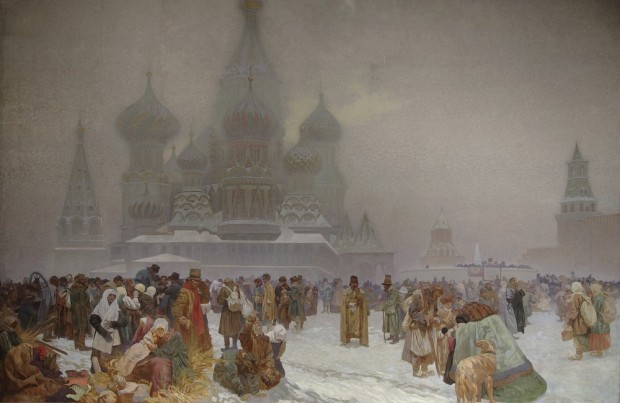'The Slav Epic cycle' No.19: The Abolition of Serfdom in Russia. To Work in Freedom Is the Foundation of a State (1861) (1914)
Although the subject is one of the most contemporaneous to Mucha’s lifetime, this was one of the first of the Slav Epic canvases to be completed. Mucha visited Russia in 1913 and discovered that the great Slavic nation and ally that he so revered was in fact besieged with poverty and suffering and significantly less advanced than the rest of Europe.
When Tsar Alexander II came to the throne in 1855, he instigated a number of reforms, including the Emancipation Edict in 1861 which gave Russian serfs personal freedom. For Mucha, this reform was too long overdue to be of any virtue.
Uncertain of how the reform will improve their condition, Mucha’s subdued crowd of Russian peasants looks on anxiously as the official reads the edict. St Basil’s cathedral and the Kremlin beyond are barely discernible through the thick shroud of fog which captures the uncertainty of the moment. The distant sun is just palpable through the cloud and offers a faint flicker of hope for a brighter future. Again, Mucha includes the figure of a mother and child to express both the fear and hope associated with future generations.
Related objects
-
Peasant father and son with the Tsar Bell in the background, Moscow Kremlin (1913)
Reproduced from original glass plate plate
Go to Peasant father and son with the Tsar Bell in the background, Moscow Kremlin -
Mucha sketching in Red Square, Moscow (1913)
Reproduced from original glass plate plate
Go to Mucha sketching in Red Square, Moscow -
Beggar and a bourgeois lady, Moscow (1913)
Reproduced from original glass plate plate
Go to Beggar and a bourgeois lady, Moscow





